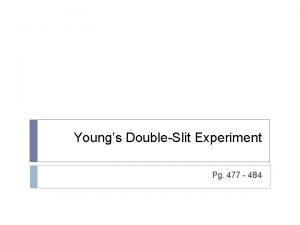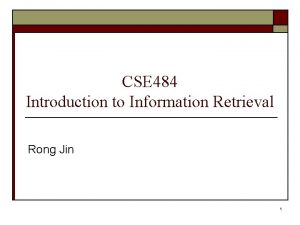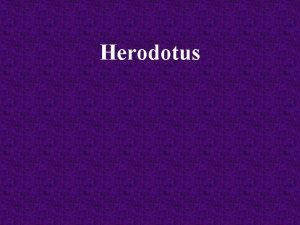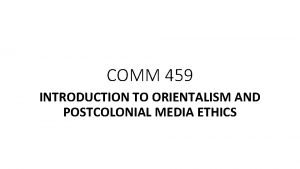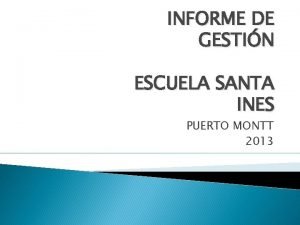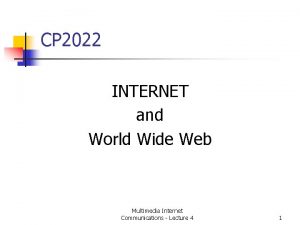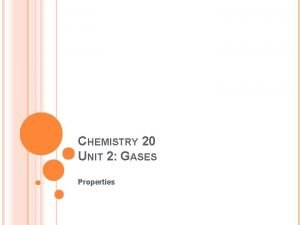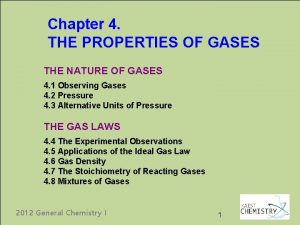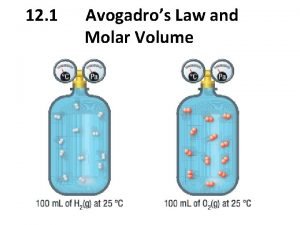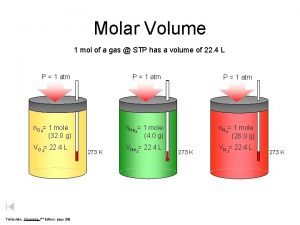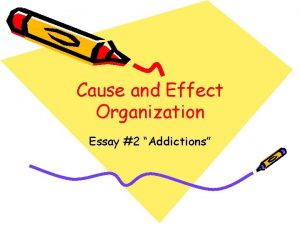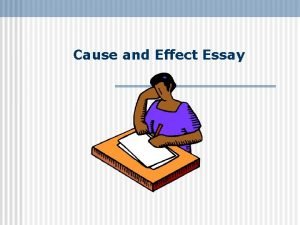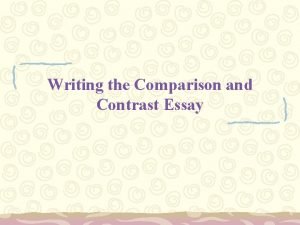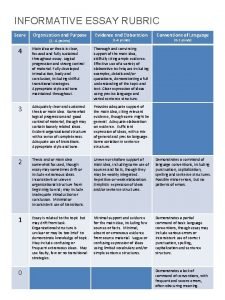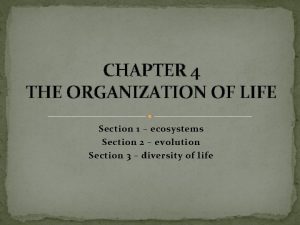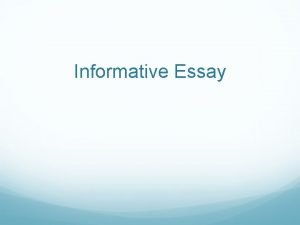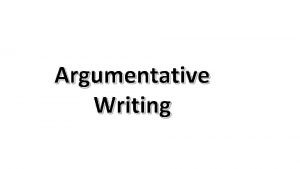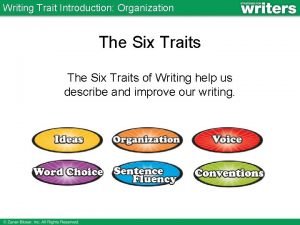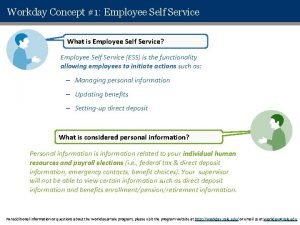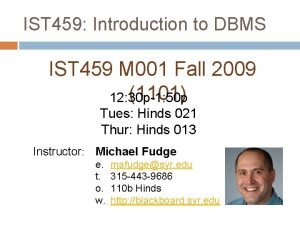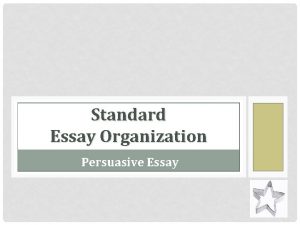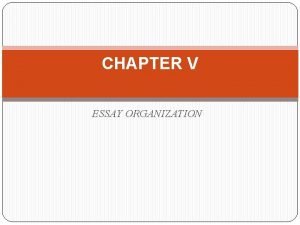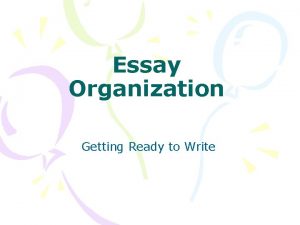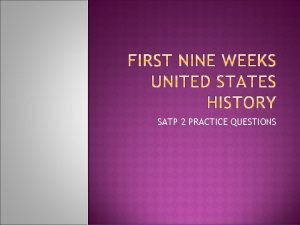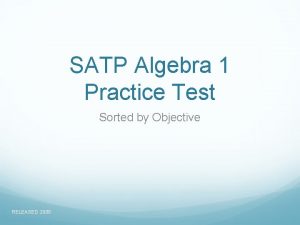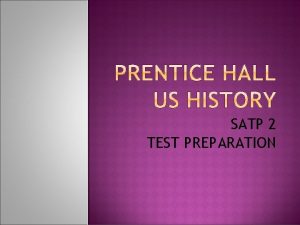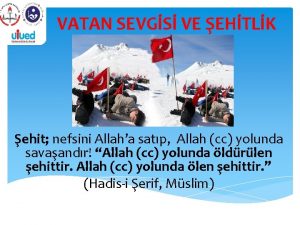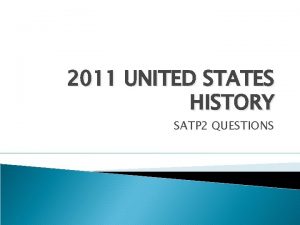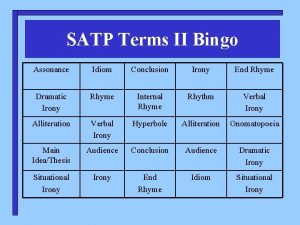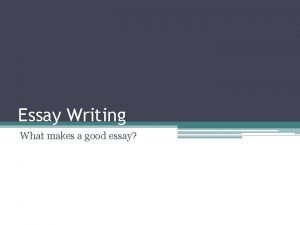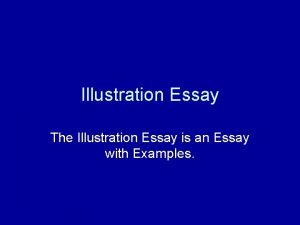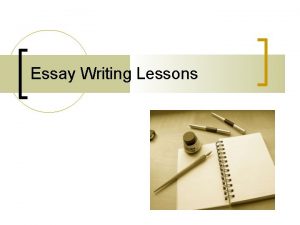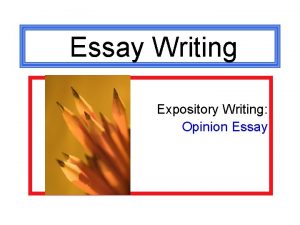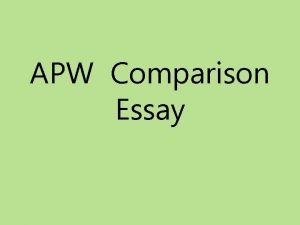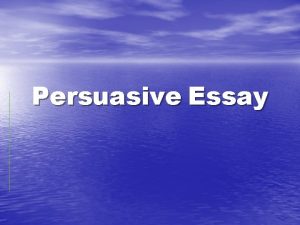Essay Organization SATP section 10 pp 459 484



































- Slides: 35

Essay Organization SATP section 10 pp. 459— 484

Words to Remember Topic sentence— --usually the first sentence (BUT the sentence can come anywhere in the paragraph. ) --gives a general idea of what the paragraph is about

A good topic sentence will catch the reader’s attention and cause him to want to know more!

Silken Status Symbols To settlers in early New England, clothes were often a measure of a person’s wealth, and people were supposed to dress according to their station in life. The wealthy dressed themselves in expensive clothes imported from London, while poorer people wore clothes made from rough homespun. Dressing above one’s station was actually against the law. In 1676, 68 young people were fined for wearing silken clothes. In a strange new world, settlers tried to hold fast to laws and customs that made society feel orderly. ----Ann Palmer • Tip: What is the whole paragraph about?

Silken Status Symbols To settlers in early New England, clothes were often a measure of a person’s wealth, and people were supposed to dress according to their station in life. The wealthy dressed themselves in expensive clothes imported from London, while poorer people wore clothes made from rough homespun. Dressing above one’s station was actually against the law. In 1676, 68 young people were fined for wearing silken clothes. In a strange new world, settlers tried to hold fast to laws and customs that made society feel orderly. ----Ann Palmer

Memory Tricks The word homes has helped many people remember the names of the Great Lakes, for each letter in the word is also the first letter of a lake’s name. The sentence “Every Good Boy Does Fine” has helped many people remember the lines on a musical staff. Whenever you have to remember a series of items, try making up a sentence with words that begin with the same letters as the items. Called mnemonics, these memory tricks often succeed when unaided memory fails. • Tip: What is the whole paragraph about?

Memory Tricks The word homes has helped many people remember the names of the Great Lakes, for each letter in the word is also the first letter of a lake’s name. The sentence “Every Good Boy Does Fine” has helped many people remember the lines on a musical staff. Whenever you have to remember a series of items, try making up a sentence with words that begin with the same letters as the items. Called mnemonics, these memory tricks often succeed when unaided memory fails.

Examples/Detail sentences— --gives support for the topic sentence --each detail sentence should state a point about the topic OR explain the point being made about the topic --Make a COMMENT, then give an EXAMPLE and an EXPLANATION. It is almost like moving back and forth in a dance.

NOTE: Eliminate any sentences that stray from the topic so the paragraph will have unity. When all of the details are arranged in logical order, the paragraph has coherence.

Concluding sentences— --are the last sentence in a paragraph --can give an opinion --can restate the topic in a different way --can briefly summarize the topic

A concluding sentence --does NOT leave the reader hanging! --does NOT introduce new information! --does NOT simply give more details about the topic!

**** TIP *** Read the paragraph with your selected concluding sentence to see if fits! Mark out answer choices that are off – topic give just another detail introduce new information Complete pg. 462—practice 1 be prepared to explain why the wrong choices are wrong

Evaluate your paragraphs— The paragraph is on-mode (informative—explaining why about something). The paragraph is on-topic (changes you would make to your school or community). The paragraph has a topic sentence. The paragraph shows regard (consideration) for audience. The paragraph has elaborated (enough) supporting details. The paragraph has a concluding sentence. The paragraph has some errors in grammar and mechanics.

Choosing introductory sentences---look at the given in the examples and details to see what general topic is being addressed --use the www. knowledge tip ask WHAT is this paragraph really ABOUT? ? --look at the concluding sentence for a clue (remember concluding sentences can summarize the topic or restate the topic)

*** TIP *** Read the paragraph with your selected introduction to see if it fits.

*** TIP *** Mark out answer choices that are --off topic --vague --just another detail Complete pg. 464—practice 2

Section 10. 2 Words to Remember Introduction --the first paragraph of an essay --introduces the topic of the essay --usually contains thesis statement

Thesis statement --the controlling idea for an essay Body --one or more paragraphs that support thesis statement Conclusion --the paragraph that ends the essay

Selecting thesis statements— --for an informative essay, thesis statement commonly gives a list of general examples to be discussed in more detail --be sure thesis statement actually addresses the prompt Complete pg. 468, practice 1

Selecting thesis statements---for a persuasive essay, thesis statement usually give two or three opinions to support the topic --be sure thesis statement gives a clear opinion and the reasons can be “argued” Complete pg. 470, practice 2

Selecting a thesis statement using the body paragraphs (Section 10. 3) --read the body paragraphs --pick out the main idea for EACH body paragraph --use the www. knowledge tip In other words, name the WHO, WHAT, and WHY (why are they giving you this— the mode) for each paragraph

--select thesis statement that contains those ideas --Note: The thesis statement can be given in more than one sentence. Complete pg. 470

Section 10. 4 Selecting introductions based on the body and conclusions---look at the body paragraph and the concluding paragraphs --pick out the main topics for each paragraph (use www. knowledge)

--now look for the introductory paragraph that has a thesis statement that addresses those topics --Having trouble? Remember!—the conclusion often restates or summarizes the topic. So, what are the main ideas in the conclusion? Complete pg. 476

Select concluding paragraphs using topics from an outline— --use the same tips as when selecting concluding paragraphs --should not repeat the introductory paragraph --does not give details that should have been in the body of the essay --SHOULD mention general ideas from thesis and the topics --should bring the essay to a logical end Complete pg. 479 (answers follow)

Section 10. 3, pg. 471 -473 1. A b—too general; no mention of the resentment c—“record” a program-false info leaves out the weather d—leaves out the weather

2. C a—only talks about paragraph 1 b—omits paragraph 3 d—“habits is too general doesn’t really address the writer’s pleasure

Section 10. 4, pg. 475 Example 1: C a—leaves out about territory and song b—leaves out about nests d—negative tone but the passage has a positive tone

Section 10. 4, pp. 476 -477 1. B a—too general -- “size” and “weight of line” not addressed in the essay c— “top water lures” introduces new info d— doesn’t name the lures, so this one is too general -- passage doesn’t guarantee success as this answer response suggests

2. D a—too narrow b—too general; not all points covered c—info that is not in the essay

Pg. 478 Example 2—B a—only has specifics about behavior c—only specific about appearance d—sounds more like an intro doesn’t “close” the essay

Pg. 479 1. D a—leaves out disease and change b—too general; only talks about Columbus c—leaves out info about how they were treated

2. B a—too narrow; only about heights c—leaves out about heights d—introduces new general information


Complete the section 10 review on pp. 480— 484. Explain why the wrong ones are wrong.
 Experiment 484
Experiment 484 Cse484
Cse484 Cs 484 bilkent
Cs 484 bilkent 484 bc
484 bc Comm 459
Comm 459 Escuela santa ines puerto montt
Escuela santa ines puerto montt 459-393-385
459-393-385 Molar mass equation for gas
Molar mass equation for gas Stp and satp
Stp and satp Satp volume
Satp volume Law of combining volumes
Law of combining volumes 1 mol gas 22 4 liter
1 mol gas 22 4 liter Process organization in computer organization
Process organization in computer organization Point by point organization essay
Point by point organization essay Block and chain essay
Block and chain essay Cause and effect introduction
Cause and effect introduction Expository essay introduction format
Expository essay introduction format Parts of an essay
Parts of an essay Block method outline
Block method outline Writing an essay
Writing an essay Explanatory essay rubric
Explanatory essay rubric Chapter 4 the organization of life section 1
Chapter 4 the organization of life section 1 Structure of expository essay
Structure of expository essay Argumentative writing vs persuasive writing
Argumentative writing vs persuasive writing Explanatory vs argumentative essay
Explanatory vs argumentative essay Whats an argumentative essay
Whats an argumentative essay Full sectional view
Full sectional view Section view
Section view Full section
Full section Section 2 describing energy (continued)
Section 2 describing energy (continued) Chapter 10 section 1: meiosis
Chapter 10 section 1: meiosis Writing trait organization
Writing trait organization Function of world trade organization
Function of world trade organization World nature organization is located in
World nature organization is located in Workday yale
Workday yale Non profit organization mission
Non profit organization mission
